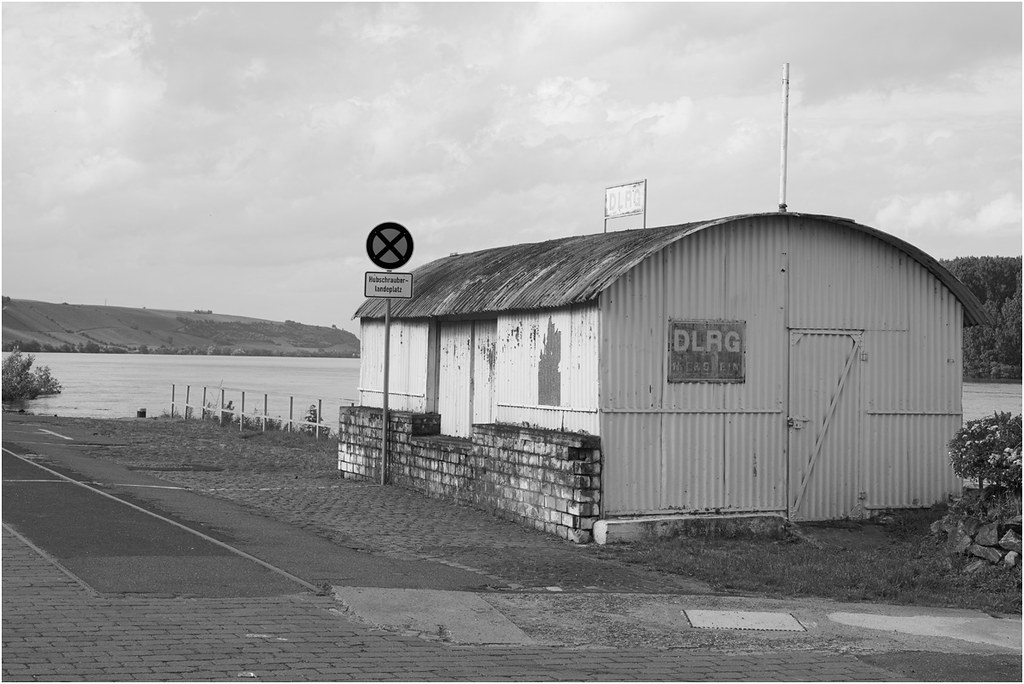.
![Doon Well, Donegal Highlands, Termon, Co. Donegal | by National Library of Ireland on The Commons]()
Doon Well, Donegal Highlands, Termon, County Donegal: photographer unknown, between ca.1900-1939 (Eason Photographic Collection, National Library of Ireland)
Can help to facilitate cures. Crutches, bandages and rosary beads left behind
Miracle cures obsessed the good women in my mother's parish circle.
Lourdes was a common destination for devout pilgrims with terminal illnesses.
I marveled at the strength of my friend. The believer. He retained his generous sense of humour
The women in my mother's parish circle prayed in a group. They met in one another's living rooms
But nobody complained, everything was given up for and suffered on behalf of
Never played a part, was never a part of anyone's motive, in fact would have ruined
Are the marks of damage and decomposition, in which sense every old photo
![Sad eyes or scary eyes? | by National Library of Ireland on The Commons]()
Woman at Doon Well, Kilcrenan, County Donegal: stereoscopic view by James Simonton / Frederick Mares (?), c. 1870 (Lawrence Photographic Collection, National Library of Ireland)
From the DIA: Class: Ritual site - holy well
Townland: DOON
![Doon Well at Kilmacrenan | by National Library of Ireland on The Commons]()
Doon Well, Kilmacrenan, County Donegal: photo by Robert French (?), c. 1900 (Lawrence Photographic Collection, National Library of Ireland)
![The Square, Baltinglass, Co. Wicklow | by National Library of Ireland on The Commons]()
The Square, Baltinglass. County Wicklow: photographer unknown, between ca.1900-1939 (Eason Photographic Collection, National Library of Ireland)
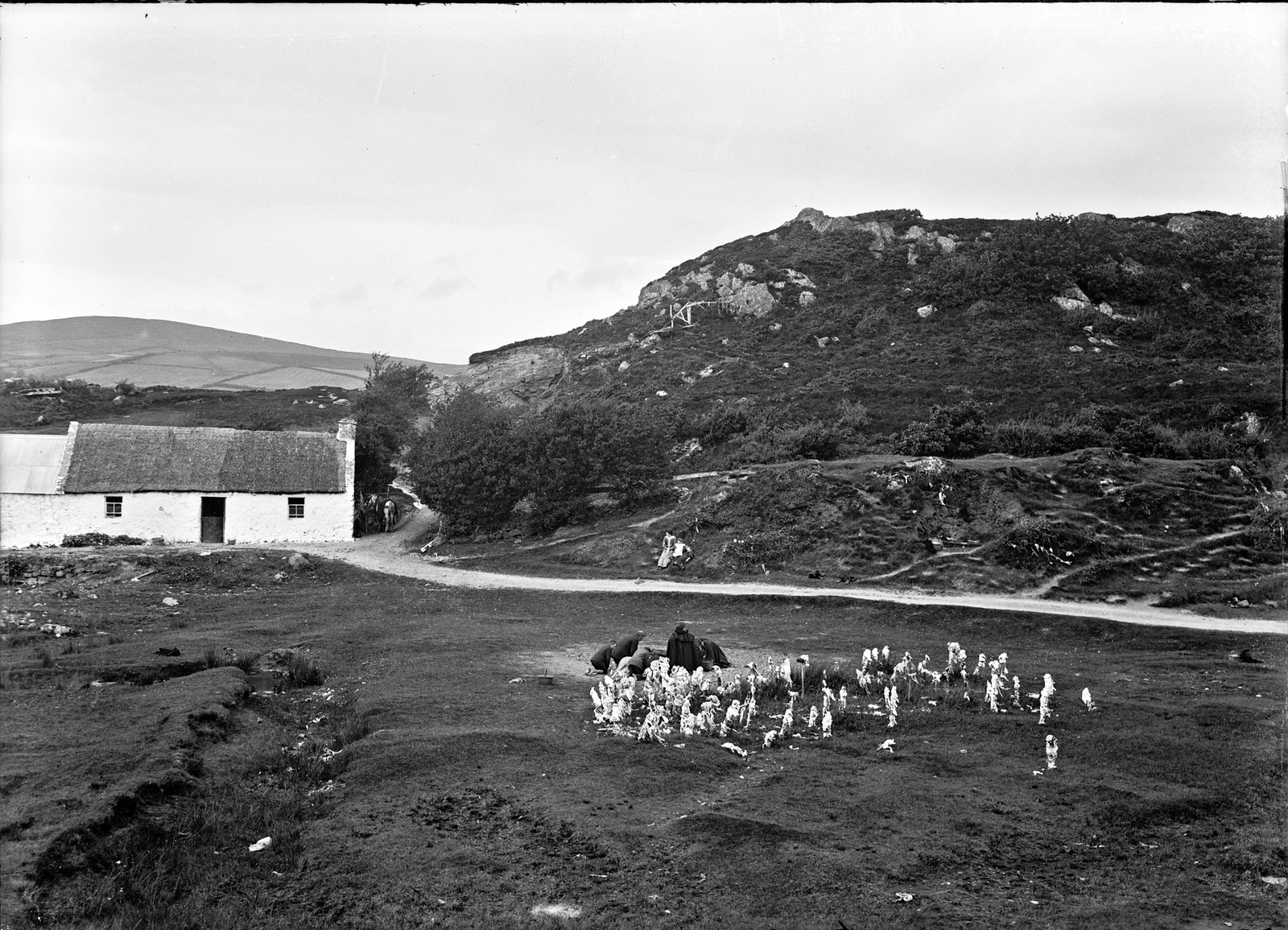
Doon Well, Donegal Highlands, Termon, County Donegal: photographer unknown, between ca.1900-1939 (Eason Photographic Collection, National Library of Ireland)
I
Ablutions, dipping in the waters, washing the afflicted parts with a cloth,
Ablutions, dipping in the waters, washing the afflicted parts with a cloth,
Tying the wet washcloth to a branch. The rag disintegrates over time,
The ailment is supposed to fade away as well. Circumambulation (or circling)
Of the well a set number of times and making an offering of a coin, pin or stone
The ailment is supposed to fade away as well. Circumambulation (or circling)
Of the well a set number of times and making an offering of a coin, pin or stone
Can help to facilitate cures. Crutches, bandages and rosary beads left behind
Give evidence of the miraculous in actu. The Well rises within
An expanse of greensward, through which a tiny stream wanders silently,
Without murmur, without ripple. In the marshy soil rushes grow in profusion
And blue and yellow flowers lift their bright heads. On one side the marsh is bounded
By the rocky height of Doon, and on the other by a lower, longer, grass-clad hill.
One white-washed, straw-thatched little cottage nestling under the shadow of Doon Rock
Is the only sign of human habitation. A narrow, rutty road leads across the bog to the Well.
It makes more evident the loneliness of the spot, for it seems to remind
That there is a beyond, a place of life, of noise, of rush.
This long white streak unites Doon with the outside world. ...
An expanse of greensward, through which a tiny stream wanders silently,
Without murmur, without ripple. In the marshy soil rushes grow in profusion
And blue and yellow flowers lift their bright heads. On one side the marsh is bounded
By the rocky height of Doon, and on the other by a lower, longer, grass-clad hill.
One white-washed, straw-thatched little cottage nestling under the shadow of Doon Rock
Is the only sign of human habitation. A narrow, rutty road leads across the bog to the Well.
It makes more evident the loneliness of the spot, for it seems to remind
That there is a beyond, a place of life, of noise, of rush.
This long white streak unites Doon with the outside world. ...
The outside world, that's where we are. Were we ever elsewhere?
Those in mother's parish circle who suffered the most grievous afflictions
Returned from pilgrimages to the holy wells of Ireland imbued with a fresh distillation
Of holiness. The women would gather in each other's living rooms and say
Rosaries over and over, holding the beads aloft with cancer-weakened arms.
Ablutions, dipping in the waters, washing the afflicted parts with a cloth,
Tying the wet washcloth to a branch. The rag disintegrated over time,
The ailment was supposed to fade away as well. Also circumambulation, circling
Of the well a set number of times and making an offering of a coin, pin or stone.
The ailment was supposed to fade away as well. Also circumambulation, circling
Of the well a set number of times and making an offering of a coin, pin or stone.
II
A friend died recently after "a long struggle with...". This friend was equally
A believer, though of a faith nothing like my mother's. Still his devotion to prayer
And to the ritual iteration of the articles of his belief proved his great strength in his going. Miracle cures obsessed the good women in my mother's parish circle.
Lourdes was a common destination for devout pilgrims with terminal illnesses.
I marveled at the strength of my friend. The believer. He retained his generous sense of humour
The nimble lightness and thoughtfulness till...
A curtain comes down. Nobody ever really believes they are going to die,
Else how would it be possible to draw one more breath,
Until... and then they do. I don't know if people believe in miracle cures any more.
The women in my mother's parish circle prayed in a group. They met in one another's living rooms
And said the rosary with hands holding the beads aloft strung across both extended arms
And the murmuring susurrations of this group of women as they prayed
Contained as I then guessed all the accumulated woes and hardships of their several lives
In which grief and illness and habits of pinching and scrimping were general and constant
But nobody complained, everything was given up for and suffered on behalf of
The Poor Souls, and of course the Poor Souls would never know
So there were really never any perceptible returns upon all this athletic investment
Of prayer on the part of these in fact no longer young women,
And anyway profit even spiritual profit even profit for the Poor Souls
Never played a part, was never a part of anyone's motive, in fact would have ruined
Everything. One another's company would have to have been the gain,
The communal benefit of shared company as one would have to suppose
Rather than actually remember, the actual memory is like an old photo
Scratched and marred by years of handling, so that what one most notices now
Scratched and marred by years of handling, so that what one most notices now
Are the marks of damage and decomposition, in which sense every old photo
Is also a photo of death, for nothing in it is alive any more, and knowing this
Ought to make one feel sad in looking, and sometimes that does happen
But more often now the mind is merely a clouded window upon...
So that the nights go by and... no praying and... no miracle cure so...
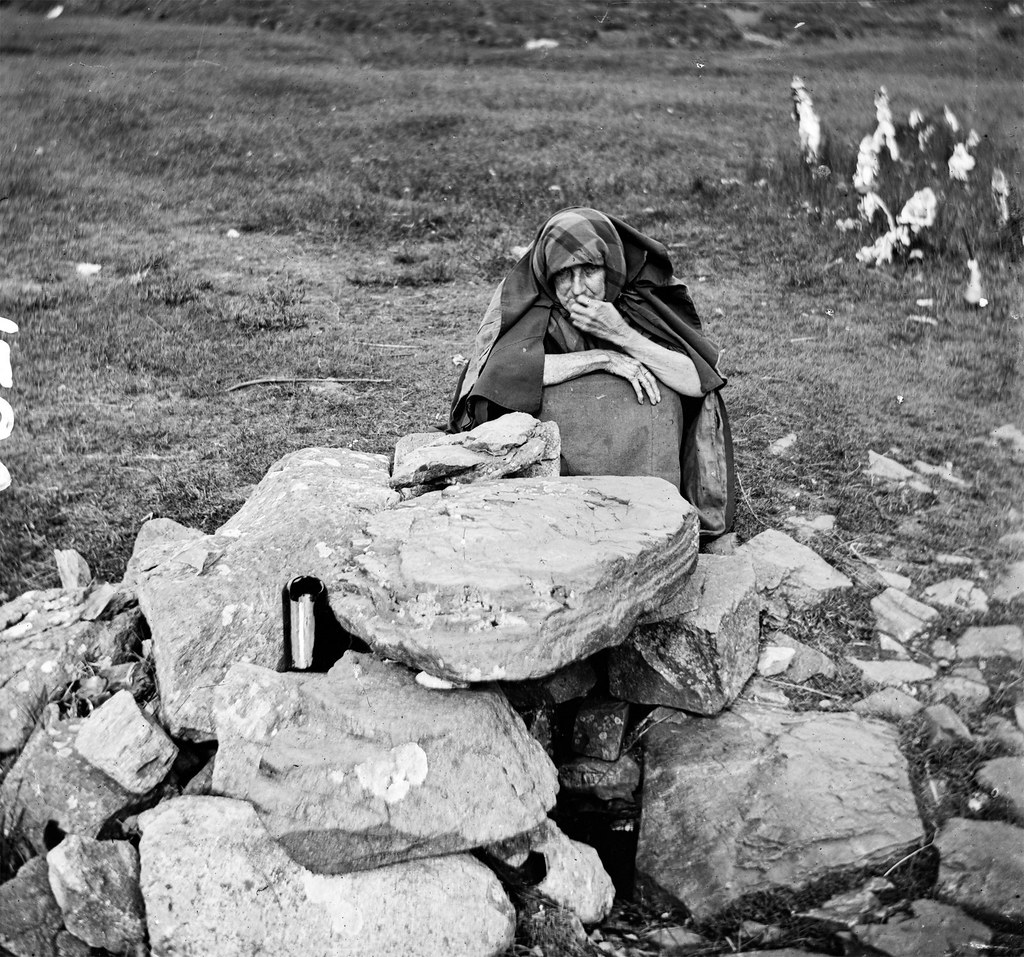
Woman at Doon Well, Kilcrenan, County Donegal: stereoscopic view by James Simonton / Frederick Mares (?), c. 1870 (Lawrence Photographic Collection, National Library of Ireland)
From the DIA: Class: Ritual site - holy well
Townland: DOON
Description: Doon Well consists of a modern, enclosing wall from which steps lead down to a spring well. Nearby is a sapling to which are attached mementoes of the cures sought at the well. The area was landscaped in 2006 (SMR file). Kinahan (1889, 284) records the following regarding Doon rock: 'Its modern fame is said to be due to Fathers Freel and Gallagher, who, after being in foreign parts for many years, returned about two hundred years ago to this country, and blessed the adjoining well, since which time it is much resorted to by pilgrims in the summer and autumn, the waters curing cripples, sore eyes, and various other ailments; while water carried from the well, and sprinkled on the crops, stops the potato disease, blight in corn, and various other disasters. Of late years, the number of pilgrims have so much increased that a public road has been made into the well.’ It was described by Ó Muirgheasa in 1936: 'Doon Well, beside Doon Rock, and not far from Kilmacrenan, is now the most frequented Holy Well in Tirconaill, though one of the youngest -- if popular tradition speaks true -- as its origin is ascribed to Lector O'Friel. Local tradition says he is buried in Kilmacrenan old graveyard, and a white stone in the wall over the grave marks the spot. There is no special feast day or season for this pilgrimage. Prayers to be said at the well: Our Father and Hail Mary (five times) and Creed for your Intention. Same for every bottle of water you take. Our Father and Hail Mary for Father Friel who found it. Same for Father Gallagher who blessed it. Same for the man who put shelter around it"' (Ó Muirgheasa 1936, No. 81, 155-6).
The above description was derived from the 'Archaeological Survey of County Donegal. A description of the field antiquities of the County from the Mesolithic Period to the 17th century.' Compiled by: Brian Lacey with Eamon Cody, Claire Cotter, Judy Cuppage, Noel Dunne, Vincent Hurley, Celie O'Rahilly, Paul Walsh and Seán Ó Nualláin (Lifford: Donegal County Council, 1983). In this instance the entry has been revised and updated.
The above description was derived from the 'Archaeological Survey of County Donegal. A description of the field antiquities of the County from the Mesolithic Period to the 17th century.' Compiled by: Brian Lacey with Eamon Cody, Claire Cotter, Judy Cuppage, Noel Dunne, Vincent Hurley, Celie O'Rahilly, Paul Walsh and Seán Ó Nualláin (Lifford: Donegal County Council, 1983). In this instance the entry has been revised and updated.
-- Niall McAuley, commenter at National Library of Ireland
And the nearby Doon Rock: Class: Inauguration site
Townland: DOON
Scheduled for inclusion in the next revision of the RMP: Yes
Description: Doon Rock is traditionally believed to be the inauguration site of the O'Donnells. In some respects, it can be said to resemble an inland promontory fort. It consists of a natural mound of rock somewhat oval in plan c. 150m N-S and c. 75m E-W. It rises dramatically from the surrounding wet land and is naturally defensive.
Townland: DOON
Scheduled for inclusion in the next revision of the RMP: Yes
Description: Doon Rock is traditionally believed to be the inauguration site of the O'Donnells. In some respects, it can be said to resemble an inland promontory fort. It consists of a natural mound of rock somewhat oval in plan c. 150m N-S and c. 75m E-W. It rises dramatically from the surrounding wet land and is naturally defensive.
-- Niall McAuley, commenter at National Library of Ireland
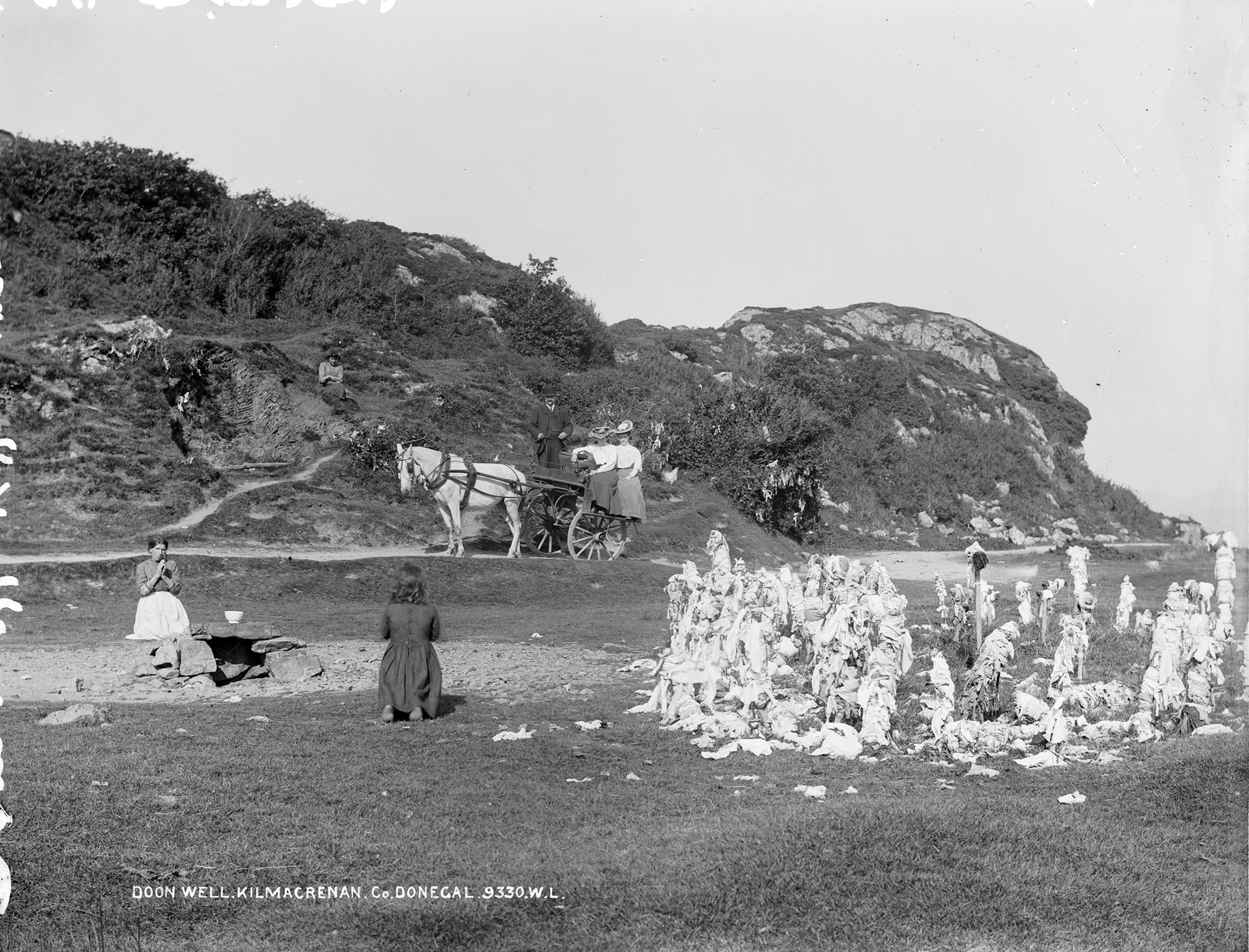
Doon Well, Kilmacrenan, County Donegal: photo by Robert French (?), c. 1900 (Lawrence Photographic Collection, National Library of Ireland)
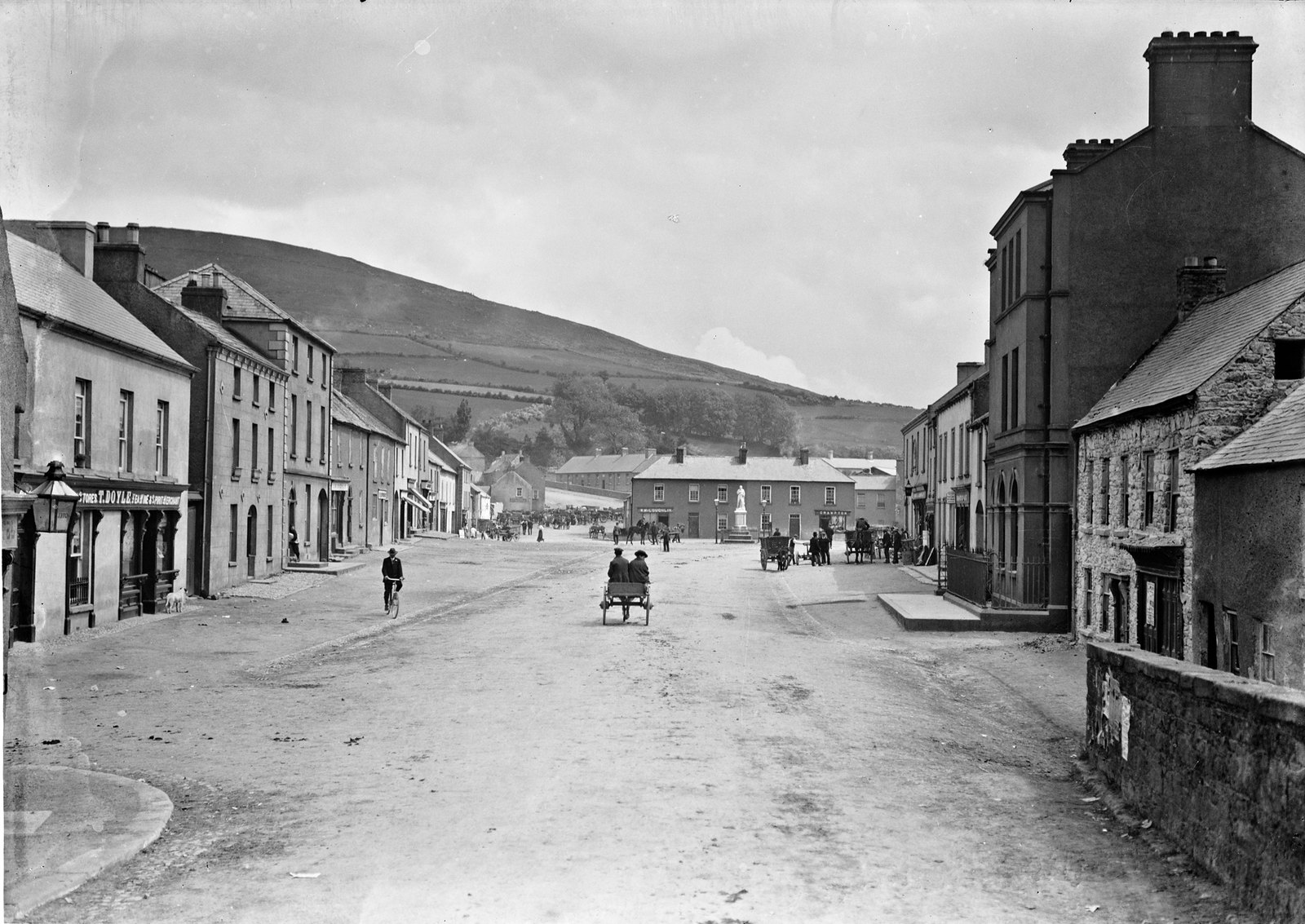
The Square, Baltinglass. County Wicklow: photographer unknown, between ca.1900-1939 (Eason Photographic Collection, National Library of Ireland)
